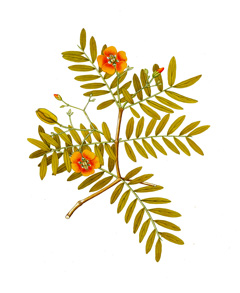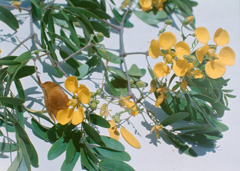 |
|
https://edibleplants.org/ |
 |
| tropicos.org |
Translate this page:
Summary
Verawood or Bulnesia arborea is a slow-growing, evergreen, flowering tree that grows around 15 m high with trunk diameter of up to 50 cm. It is drought tolerant and sometimes used as an ornamental plant. It is native to Colombia and Venezuela and known for its durable timber used in water turbines, mallet heads, pulley wheels, brush backs, and for railway crossties. Verawood can be grown through seeds, cuttings, or layering.
Physical Characteristics

 Bulnesia arborea is an evergreen Tree growing to 15 m (49ft) by 16 m (52ft) at a slow rate.
Bulnesia arborea is an evergreen Tree growing to 15 m (49ft) by 16 m (52ft) at a slow rate.
See above for USDA hardiness. It is hardy to UK zone 9 and is frost tender.
Suitable for: light (sandy), medium (loamy) and heavy (clay) soils and prefers well-drained soil. Suitable pH: neutral and basic (mildly alkaline) soils and can grow in very alkaline and saline soils.
It cannot grow in the shade. It prefers dry or moist soil and can tolerate drought. The plant can tolerates strong winds but not maritime exposure.
UK Hardiness Map
US Hardiness Map
Synonyms
Guaiacum arboreum (Jacq.) DC. Zygophyllum arboreum Jacq.
Plant Habitats
Edible Uses
References More on Edible Uses
Medicinal Uses
Plants For A Future can not take any responsibility for any adverse effects from the use of plants. Always seek advice from a professional before using a plant medicinally.
None known
References More on Medicinal Uses
The Bookshop: Edible Plant Books
Our Latest books on Perennial Plants For Food Forests and Permaculture Gardens in paperback or digital formats.

Edible Tropical Plants
Food Forest Plants for Hotter Conditions: 250+ Plants For Tropical Food Forests & Permaculture Gardens.
More

Edible Temperate Plants
Plants for Your Food Forest: 500 Plants for Temperate Food Forests & Permaculture Gardens.
More

More Books
PFAF have eight books available in paperback and digital formats. Browse the shop for more information.
Shop Now
Other Uses
Wood
Other uses rating: High (4/5). Large flowering tree, Street tree, Specimen, Public open space, Bonsai subject, Xerophytic. The timber is exceptionally durable and so the tree is commonly harvested from the wild. It is also sometimes grown as an ornamental[307]. The heartwood is more or less striped and banded, varying in colour from light olive green to chocolate brown[ 316 ]. The surface of fresh wood often turns dark green upon exposure[ 316 ]. The sapwood is mostly thin and light yellow in colour[ 316 ]. The wood is fine textured, cross-grained, with an oily appearance and feel, mildly and pleasantly scented when warmed[ 316 ]. Owing to its high density and the resinous nature of the timber, the wood dries slowly and needs careful handling to avoid splitting, it is also prone to ring shake[ 316 ]. When seasoned, it is not easy to work either with machine or hand tools but does turn well in the lathe[ 316 ]. The heartwood is very durable under exposure and will last indefinitely in the ground[ 316 ]. There are reports that posts made from it have lasted for 300 years without rotting[ 307 ]. Because of its high density and self-lubrication, the wood has many uses similar to that of Lignum vitae (Guaiacum officinale), but is not considered as suitable for propeller-shaft bushings[ 316 ]. It is used as steps and collars for water turbines, mallet heads, pulley wheels, brush backs, locally for railway crossties[ 316 ].
Special Uses
References More on Other Uses
Cultivation details
Prefers a fertile, well-drained soil and a position in full sun[ 307 ]. Established plants are very drought tolerant and also tolerate salt-laden winds[ 307 ].
References Carbon Farming Information and Carbon Sequestration Information
Temperature Converter
Type a value in the Celsius field to convert the value to Fahrenheit:
Fahrenheit:
The PFAF Bookshop
Plants For A Future have a number of books available in paperback and digital form. Book titles include Edible Plants, Edible Perennials, Edible Trees,Edible Shrubs, Woodland Gardening, and Temperate Food Forest Plants. Our new book is Food Forest Plants For Hotter Conditions (Tropical and Sub-Tropical).
Shop Now
Plant Propagation
Seed - Cuttings. Layering.
Other Names
If available other names are mentioned here
Verawood or Bulnesia arborea
Native Range
SOUTHERN AMERICA: Venezuela, Colombia
Weed Potential
Right plant wrong place. We are currently updating this section.
Please note that a plant may be invasive in one area but may not in your area so it's worth checking.
None Known
Conservation Status
IUCN Red List of Threatened Plants Status : This taxon has not yet been assessed.

Growth: S = slow M = medium F = fast. Soil: L = light (sandy) M = medium H = heavy (clay). pH: A = acid N = neutral B = basic (alkaline). Shade: F = full shade S = semi-shade N = no shade. Moisture: D = dry M = Moist We = wet Wa = water.
Now available:
Food Forest Plants for Mediterranean Conditions
350+ Perennial Plants For Mediterranean and Drier Food Forests and Permaculture Gardens.
[Paperback and eBook]
This is the third in Plants For A Future's series of plant guides for food forests tailored to
specific climate zones. Following volumes on temperate and tropical ecosystems, this book focuses
on species suited to Mediterranean conditions—regions with hot, dry summers and cool, wet winters,
often facing the added challenge of climate change.
Read More
Expert comment
Author
(Jacq.) Engl.
Botanical References
Links / References
For a list of references used on this page please go here
A special thanks to Ken Fern for some of the information used on this page.
Readers comment
| Add a comment |
|
If you have important information about this plant that may help other users please add a comment or link below. Only comments or links that are felt to be directly relevant to a plant will be included. If you think a comment/link or information contained on this page is inaccurate or misleading we would welcome your feedback at [email protected]. If you have questions about a plant please use the Forum on this website as we do not have the resources to answer questions ourselves.
* Please note: the comments by website users are not necessarily those held by PFAF and may give misleading or inaccurate information.
To leave a comment please Register or login here All comments need to be approved so will not appear immediately.
|
Subject : Bulnesia arborea
|
|
|
|